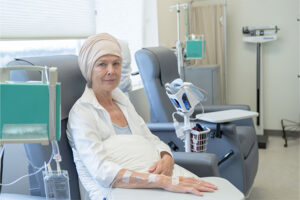Oncology
HER2+ Breast Cancer
Early HER2+ Breast Cancer: How Should Pathological Responses to Neoadjuvant Therapy at the Time of Surgery Guide Decisions About Adjuvant Treatment?
Overview
Neoadjuvant therapy for early-stage human epidermal growth factor receptor 2–positive (HER2+) breast cancer has become an important treatment standard. Pathological response at the time of surgery is a valuable prognostic that also helps shape decisions about adjuvant therapy.
Expert Commentary
Sara M. Tolaney, MD, MPH
|
|
“If, after neoadjuvant therapy, such patients have a pCR, I think that the main controversy is whether they need to continue on both trastuzumab and pertuzumab, or if they can just receive trastuzumab alone. My argument would be that these patients should receive dual HER2-directed therapy in the adjuvant setting since our long-term outcomes data come from APHINITY, where patients received a full year of trastuzumab and pertuzumab.”
In patients with early HER2+ breast cancer, giving neoadjuvant therapy and determining the pathological response at the time of surgery allows us to better understand the tumor’s sensitivity to systemic therapy and to guide adjuvant treatment recommendations. In those patients with a tumor that is more than 2 cm or with lymph node involvement, we do want to make sure that they receive preoperative therapy, and we will usually give the TCHP regimen, which is a combination of docetaxel, carboplatin, trastuzumab, and pertuzumab, for 6 cycles.
Such patients with residual disease at the time of surgery have worse outcomes than those who have a pathological complete response (pCR), but we can essentially rescue them by giving trastuzumab emtansine (T-DM1) instead of trastuzumab in the setting of residual disease. The use of T-DM1 is based on the results of KATHERINE, a phase 3 trial that enrolled patients with early HER2+ breast cancer who had residual invasive disease at the time of surgery after receiving neoadjuvant therapy with a taxane and trastuzumab. In this study, the use of adjuvant T-DM1 was associated with a 50% reduction in the risk of recurrence of invasive breast cancer or death compared with adjuvant trastuzumab. In addition, the 3-year rate of invasive disease-free survival was estimated at approximately 88% in patients receiving T-DM1, which is a really big deal because it means that most individuals who received T-DM1 did not recur. There are a number of ongoing studies attempting to further improve outcomes for patients with residual disease by adding tucatinib or by replacing T-DM1 with trastuzumab deruxtecan.
If, after neoadjuvant therapy, such patients have a pCR, I think that the main controversy is whether they need to continue on both trastuzumab and pertuzumab, or if they can just receive trastuzumab alone. My argument would be that these patients should receive dual HER2-directed therapy in the adjuvant setting since our long-term outcomes data come from APHINITY, where patients received a full year of trastuzumab and pertuzumab. In Europe, for example, it is not always standard to give patients the pertuzumab; they often do not have approval to do that. When we use pertuzumab, we really need to remember that the data showing long-term benefit were in the setting of a full year of treatment, so I think that it is important to give patients the full year of pertuzumab.
Although these individuals have very good outcomes with the combination, some will argue that pertuzumab has not shown benefit in patients with node-negative disease (ie, in a subgroup analysis of the APHINITY trial, patients with node-negative disease did not seem to have a disease-free or overall survival benefit after 8 years of follow-up). However, my counterargument would be that we do not evaluate nodal status prior to the use of neoadjuvant therapy, so we do not really know the true nodal status of the patients in this trial.
References
Barot SV, Roesch E, Abraham J. Optimizing adjuvant and post-neoadjuvant therapy in HER2-positive early breast cancer. Expert Rev Anticancer Ther. 2022;22(12):1289-1299. doi:10.1080/14737140.2022.2146580
Cardoso F, Kyriakides S, Ohno S, et al; ESMO Guidelines Committee. Early breast cancer: ESMO clinical practice guidelines for diagnosis, treatment and follow-up [published corrections appear in Ann Oncol. 2019;30(10):1674 and Ann Oncol. 2021;32(2):284]. Ann Oncol. 2019;30(8):1194-1220. doi:10.1093/annonc/mdz173
Harbeck N. Neoadjuvant and adjuvant treatment of patients with HER2-positive early breast cancer. Breast. 2022;62(suppl 1):S12-S16. doi:10.1016/j.breast.2022.01.006
Loibl S, Jassem J, Sonnenblick A, et al. Updated results of APHINITY at 8.4 years median follow-up [abstract VP6-2022]. Abstract presented at: 2022 European Society for Medical Oncology Virtual Plenary; July 14-15, 2022.
Vazquez JC, Antolin S, Ruiz-Borrego M, et al. Dual neoadjuvant blockade plus chemotherapy versus monotherapy for the treatment of women with non-metastatic HER2-positive breast cancer: a systematic review and meta-analysis. Clin Transl Oncol. 2023;25(4):941-958. doi:10.1007/s12094-022-02998-2
von Minckwitz G, Huang C-S, Mano MS, et al; KATHERINE Investigators. Trastuzumab emtansine for residual invasive HER2-positive breast cancer. N Engl J Med. 2019;380(7):617-628. doi:10.1056/NEJMoa1814017
von Minckwitz G, Procter M, de Azambuja E, et al; APHINITY Steering Committee and Investigators. Adjuvant pertuzumab and trastuzumab in early HER2-positive breast cancer [published correction appears in N Engl J Med. 2017;377(7):702]. N Engl J Med. 2017;377(2):122-131. doi:10.1056/NEJMoa1703643











